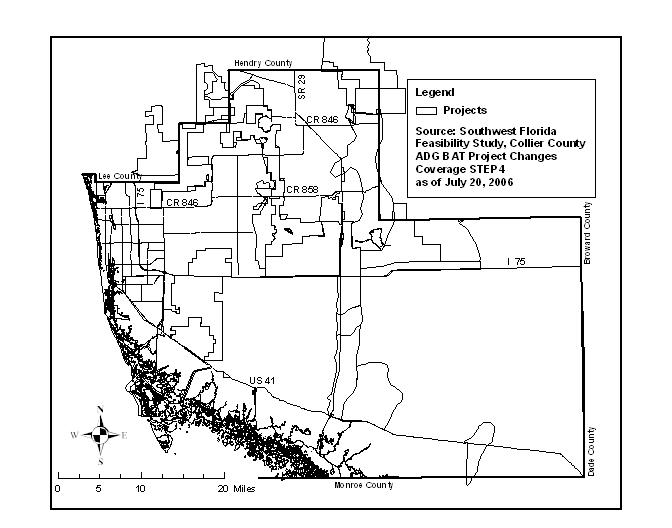 |
Collier County |
 |
Land Development Code |
 |
Chapter 3. RESOURCE PROTECTION |
 |
Appendix 3.07.00. INTERIM WATERSHED MANAGEMENT REGULATIONS |
§ 3.07.02. Interim Watershed Regulations
A.
All new development and redevelopment projects, except public roadway projects as defined in the Metropolitan Planning Organization (MPO) Long Range Transportation Plan, shall meet 150% of the water quality volumetric requirements of Section 5.2.1(a) of the Basis of Review for Environmental Resource Permit Applications within the South Florida Water Management District (February 2006). The projects shall also comply with the allowable offsite discharge rates required Ordinance 2001-27, as amended. The 150% water quality volumetric requirement also applies to the County's minimum requirement of 1 inch under Ordinance 90-10, as amended; thus increasing the County's minimum requirement to 1.5 inches.
1.
The entirety of the required 150% treatment shall occur within the boundaries of the stormwater treatment system, excluding County required native vegetation preserves, which are not allowed to be incorporated into the stormwater quality treatment system.
2.
For purposes of these interim watershed management regulations, any reconfiguration of, or addition to, the on-site impervious area that equals or exceeds 50 percent of the existing on-site impervious area square footage shall be considered redevelopment of the site. Redevelopment shall also be considered as any changes to, or reconfiguration of, the building footprint and/or all other on-site impervious area which equals or exceeds 50 percent of the assessed value of the improvements on the site. In any case, the more restrictive shall apply in the determination of redevelopment. The 50 percent threshold for impervious area and/or assessed value of improvements shall be calculated cumulatively over a 5-year period.
B.
Loss of storage or conveyance volume resulting from direct impacts to wetlands shall be compensated for by providing an equal amount of storage or conveyance capacity on site and within or adjacent to the impacted wetland.
C.
Floodplain storage compensation calculation shall be provided on a case by case basis, based upon historical flooding and drainage problem area information, as determined by staff, for developments within the designated flood zones "A", "AE", and "VE" as depicted on the Flood Insurance Rate Maps published by the Federal Emergency Management Agency with an effective date of November 17, 2005. Floodplain storage compensation calculations shall be provided on a case by case basis, based upon historical flooding and drainage problem area information, as determined by staff, for areas known to be periodically inundated by intense rainfall or sheetflow conditions.
Figure 3.07.02 - 1 Areas of special evaluation for watershed system requirements.

D.
All development located within areas identified on Figure 3.07.02 - 1 shall be evaluated to determine impacts to natural wetlands , flowways , or sloughs. For this particular evaluation, natural wetlands , flowways , or sloughs shall be tentatively identified as contiguous lands having a continual preponderance of wetland or wet facultative plant species and a ground elevation through the major portion of the natural wetland , flowway , or slough at least 1 foot lower, on average, than the ground at the edge of the natural wetland, flowway, or slough. The edge of the natural wetlands , flowways , or sloughs shall be identified by field determination and based upon vegetation and elevation differences from the adjacent uplands or transitional wetlands . The County shall require the applicant to avoid direct impacts to these natural wetlands , flowways , or sloughs or, when not possible, to ensure any direct impact is minimized and compensated for by providing the same conveyance capacity lost by the direct impact.
E.
All new development and redevelopment projects shall be designed so that surrounding properties will not be adversely impacted by the project's influence on stormwater sheet flow up to the 25-year, 3-day design storm.
(Ord. No. 08-10, § 3.C)